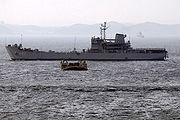
Go Jun Bong class LST
Encyclopedia
Go Jun Bong Class LST (Hangul
: 고준봉급 전차상륙함) is an Amphibious Landing Ship class of the Republic of Korea Navy
.
decided to gradually replace its aging fleet of WW2 era LST-542 class LSTs (renamed Un Bong class LST) bought from the US Navy in 1958. A three phase plan was laid out to develop new landing ships to meet the demands of modern amphibious and transport operations.
The first phase was designated as the LST-I project, and development and design started in 1987 by Korea Tacoma, currently Hanjin Heavy Industries
. After 4 years of development, the lead ship Go Jun Bong (LST 681) was launched in 1991. Three more ships followed and all four ships were commissioned by 1998.
The second phase, or LST-II, was originally planned to import four Newport class tank landing ship
s, but after being postponed due to budget issues, it was changed in favor for domestic built 4500 ton LPD
s to be commissioned by 2013-2016. These ships will ultimately replace the Un Bong and Go Jun Bong class LSTs.
LST-III was to build two mid-size helicopter amphibious landing ships, and designing started in 1997. In 2001 it was renamed as the LPX project and a total of two 14,300 ton ships were ordered for the Republic of Korea Navy
. On July 3, 2007 the lead ship Dokdo was commissioned.
The ship is designed to land multiple personnel, tanks and equipment simultaneously with doors and ramps placed on both the stern and bow of the ship, unlike the Un Bong class LST which only has doors on the bow. It is also equipped with a turn table, saving time when loading or landing vehicles.There is also a ramp for moving trucks up to the deck, and multiple elevators for rapid cargo loading.

Hangul
Hangul,Pronounced or ; Korean: 한글 Hangeul/Han'gŭl or 조선글 Chosŏn'gŭl/Joseongeul the Korean alphabet, is the native alphabet of the Korean language. It is a separate script from Hanja, the logographic Chinese characters which are also sometimes used to write Korean...
: 고준봉급 전차상륙함) is an Amphibious Landing Ship class of the Republic of Korea Navy
Republic of Korea Navy
The Republic of Korea Navy or the ROK Navy is the branch of the South Korean armed forces responsible for conducting naval operations and amphibious landing operations. The ROK Navy includes the Republic of Korea Marine Corps, which is a quasi-autonomous organization...
.
Development
In the late 1980s the Republic of Korea NavyRepublic of Korea Navy
The Republic of Korea Navy or the ROK Navy is the branch of the South Korean armed forces responsible for conducting naval operations and amphibious landing operations. The ROK Navy includes the Republic of Korea Marine Corps, which is a quasi-autonomous organization...
decided to gradually replace its aging fleet of WW2 era LST-542 class LSTs (renamed Un Bong class LST) bought from the US Navy in 1958. A three phase plan was laid out to develop new landing ships to meet the demands of modern amphibious and transport operations.
The first phase was designated as the LST-I project, and development and design started in 1987 by Korea Tacoma, currently Hanjin Heavy Industries
Hanjin Heavy Industries
Hanjin Heavy Industry Co. Ltd. is a Korean shipbuilding company, founded in 1937. It is a multinational company, and is an affiliate of the Hanjin Group.- Situation :...
. After 4 years of development, the lead ship Go Jun Bong (LST 681) was launched in 1991. Three more ships followed and all four ships were commissioned by 1998.
The second phase, or LST-II, was originally planned to import four Newport class tank landing ship
Newport class tank landing ship
Newport-class tank-landing ships are an improved class of American tank-landing ship , intended to provide substantial advantages over their World War II-era predecessors...
s, but after being postponed due to budget issues, it was changed in favor for domestic built 4500 ton LPD
Amphibious transport dock
An amphibious transport dock, also called a landing platform/dock , is an amphibious warfare ship, a warship that embarks, transports, and lands elements of a landing force for expeditionary warfare missions. Several navies currently operate this kind of ship...
s to be commissioned by 2013-2016. These ships will ultimately replace the Un Bong and Go Jun Bong class LSTs.
LST-III was to build two mid-size helicopter amphibious landing ships, and designing started in 1997. In 2001 it was renamed as the LPX project and a total of two 14,300 ton ships were ordered for the Republic of Korea Navy
Republic of Korea Navy
The Republic of Korea Navy or the ROK Navy is the branch of the South Korean armed forces responsible for conducting naval operations and amphibious landing operations. The ROK Navy includes the Republic of Korea Marine Corps, which is a quasi-autonomous organization...
. On July 3, 2007 the lead ship Dokdo was commissioned.
Design
Go Jun Bong class LST is based on the design of the LST-542 class LST, and thus its exterior is very similar to the Un Bong class LST.The ship is designed to land multiple personnel, tanks and equipment simultaneously with doors and ramps placed on both the stern and bow of the ship, unlike the Un Bong class LST which only has doors on the bow. It is also equipped with a turn table, saving time when loading or landing vehicles.There is also a ramp for moving trucks up to the deck, and multiple elevators for rapid cargo loading.

| Hull no. | Name | Launched | Commissioned |
|---|---|---|---|
| LST 681 | Go Jun Bong (고준봉) | 1991 | 1994 |
| LST 682 | Bi Ro Bong (비로봉) | 1995 | 1998 |
| LST 683 | Hyang Ro Bong (향로봉) | 1996 | 1999 |
| LST 685 | Sung In Bong (성인봉) | 1996 | 1999 |

